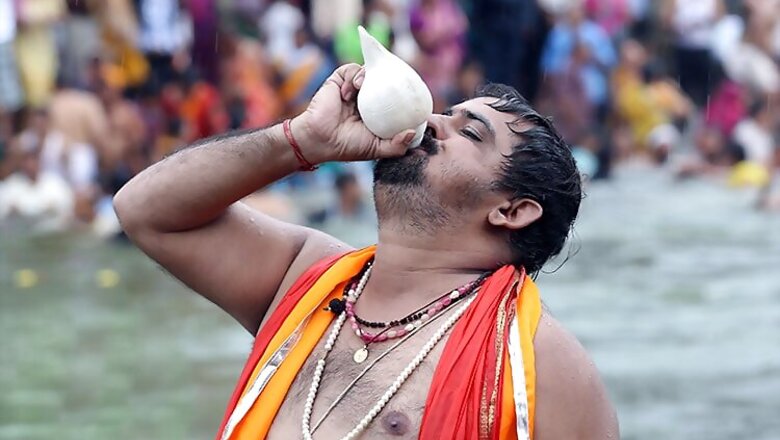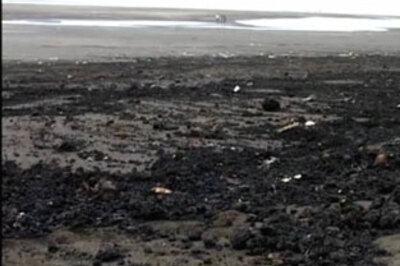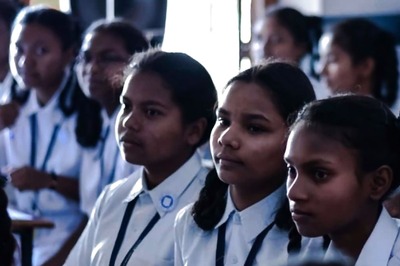
views
Nashik: At the Simhastha Kumbh Mela at Nashik-Trimbakeshwar, the millions hoping to cleanse themselves of sin are also unwittingly helping to create high-tech solutions in crowd control, disease outbreak and public security.
A group of technology innovators has launched a digital information platform at the six-week Kumbh Mela, that they say is helping to maintain order and calm among those camping near the river bank and piling into the water for one of humanity's largest religious gatherings.
Twelve years ago, dozens died in a stampede in the same festival. Halfway through this year's event there have been no such incidents as the immense crowds wade into the temperate waters of Godavari River.
"We had thought about Kumbh Mela as this gathering of masses, people who are on path of self-discovery. But in a way, innovation and innovators are also always on a path of self-discovery," said Ramesh Raskar, associate professor at the Massachusetts Institute of Technology Media Lab, which has been leading scientists, charity workers and officials from around India in a two-year effort dubbed "KumbhaThon" to develop technology solutions to better manage population-dense events.
"We want to see how we can take this amazing challenge in crowds and food and security and housing and transportation ... and see how we can make this a tech-savvy Kumbh Mela," he said.
 A devotee takes a selfie after a holy dip in the river Godavari at the Kumbh Mela. (AP Photo/Manish Swarup)
A devotee takes a selfie after a holy dip in the river Godavari at the Kumbh Mela. (AP Photo/Manish Swarup)
The digital platform, accessible by a free Android cellphone app, allows authorities and festival-goers in Nashik to collect, view and share data about festival food carts, traffic jams and the location of medical tents, giving users an up-to-date record of what's happening and where. The information is also available online at www.kumbha.org. Developers skipped making an iOS app for iPhones because there are at least 10 times as many Android users in India as those using the more expensive iPhone.
 A sadhu greets a doctor as he arrives for free medical treatment during the ongoing Kumbh Mela. (AP Photo/Tsering Topgyal)
A sadhu greets a doctor as he arrives for free medical treatment during the ongoing Kumbh Mela. (AP Photo/Tsering Topgyal)
Compiling data taken at medical tents, the app tells festival-goers about any outbreaks of dengue, jaundice and other diseases, though so far there have been no outbreaks of note. Using cellphone power data to estimate crowd sizes, the digital platform also gives officials information that helps them decide when to put up blockades or disperse crowds.
"If the density of the crowd is increasing at some location, we will control the crowd using a hold-and-release method," district official Raghunath Gawade said. "We have created many holding areas."
 A policeman keeps vigil from a vantage point, as devotees bathe in the Godavari River during the ongoing Kumbh Mela in Nashik. (AP Photo/Tsering Topgyal)
A policeman keeps vigil from a vantage point, as devotees bathe in the Godavari River during the ongoing Kumbh Mela in Nashik. (AP Photo/Tsering Topgyal)
The KumbhaThon team has discovered that most bathers prefer to go into the river in the afternoon, and mornings are relatively unpopulated. On the most auspicious bathing days, however, the riverfront is constantly jam-packed.
 Devotees gather for the third royal bath in the river Godavari during the ongoing Kumbh Mela in Nashik. (AP Photo/Ajaj Shaikh)
Devotees gather for the third royal bath in the river Godavari during the ongoing Kumbh Mela in Nashik. (AP Photo/Ajaj Shaikh)
"It's amazing. You can see where the crowds are, you can see the hot spots in the city," said Raskar, who grew up in Nashik and believes the ancient festival is ideal for launching the app. "If you look at AirBnB or Uber or redBus, they're turning the world upside down because they're relying on making smart citizens more empowered."
Government officials are embracing the new tech, and have ordered telecom companies to share data with them.
"We are getting (data on) how many people are in the vicinity of a particular tower for that company, and we are using that data to track crowds in the Nashik city as well as provide the administration with tips or analytics on how they can better plan according to that data," MIT student Mrinal Mohit said.
Another innovation for counting crowds came from a 15-year-old boy from Nashik. Hearing about the KumbaThon effort almost two years ago, Nilay Kulkami teamed up with three other tech engineers to develop a rubber doormat that counts footsteps and then reports the data back to officials.
"I wanted to do something that is useful for people. Developing a game, that's not useful. It's better to make something to help people," he said of their invention, which they call "Ashioto," which means "the power of footsteps" in Japanese.
Pilgrims at the Kumbh Mela were enthusiastic about the tech being shown through the KumbhaThon app.
 Nashik Trimbak Kumbh 2015 Android app
Nashik Trimbak Kumbh 2015 Android app
"It is really wonderful," said Khemchand Dagga, a 45-year-old who came to the festival from Hyderabad. "It will be very easy for everybody to manage the routes for the entry, exit, everything."
At the same time, the MIT team is compiling an enormous dataset that can help shed light on how people use technology.
"Millions of Indians from all over the country, of all castes, classes, races and ethnic backgrounds congregate on Nashik. And we think that this is a perfect setting to sample the country," MIT Media Lab scientist Pratik Shah said.


















Comments
0 comment